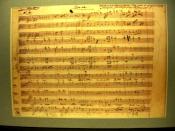In George Frederic Handel's Hallelujah Chorus, the music grows from simple to complex, as in Wolfgang Amadeus Mozart's Dies Irae. Hallelujah, like many other masses, praises God's almightiness, and lets the audience feel the power of God. The piece starts off it a modest "hallelujah" sung in unison, where the music seems quite free. When the piece begins to praise God, the music enters a firmer, more commanding tone, as the choir sings, "for the Lord Omnipotent reigneth." When declaring the epithets for the God, such as "king of kings" and "lord of lords," the voices of the choir turn forte and there are consecutive flat tones, for emphasis. When the music enters into, "The kingdom of this world...," it is piano, symbolizing something unimportant. It grows louder with "is become the," and suddenly, it is forte with "the Kingdom of our Lord and of His Christ, and of His Christ," which symbolizes its importance.
Handel pushes the repetition of "forever and ever" to make the meaning, God ruling for eternity, match the repetitive form, while the violin in the background adds complexity to the sound. Handel caps it off at the end, with a long, ceremonious "hallelujah" that reminds the audience of the glory of the kingdom of God, with a large drum playing the background that seems to hail the greatness of God. Handel has truly made a great piece of work in all aspects, which is surprising considering how fast he wrote the entire Messiah, of which the Hallelujah Chorus is only a small part of.
An another mass, the requiem mass Dies Irae, is started off furiously by Mozart, the choir singing, "Dies irae, dies illa (this day, this day of wrath)." The force in these words mirror this meaning. Since it is a...


